
Massimo Vitali, born in Como, Italy, is known all over the art world for his beach series depicting crowds of people, as well as using a unique color palette. Here Massimo Vitali talks about his artwork with Artdependence Magazine.
Massimo Vitali, born in Como, Italy, is known all over the art world for his beach series depicting crowds of people, as well as using a unique color palette. There is literally no art fair (involving photography) without Vitali’s work. It is always recognizable, and there is a warm sea breeze coming out of his landscapes. At the same time you have an opportunity to scrutinize every single person within a crowd. But how deeply did you look at them? Did you ever look at each person as a universe with one’s life experience and future expectations the way the artist expects from you? Here, Massimo Vitali talks about his artwork with Artdependence Magazine.
Artdependence Magazine: Massimo, what does the word “Inspiration” mean to you?
Massimo Vitali: Inspiration is a nasty word. I don't think my work has anything to do with inspiration. I have ideas, thoughts… it's not really much about inspiration. Everything is much colder, more calculated. I have some ideas, I see how can I use them, transform them into images and then I can do some research and decide where to place them. Obviously I have far more ideas than I can take care of! So, some ideas are rejected… Normally, ideas come to me when I am driving. I have to go to Milano to the lab once every ten days and I have a three hour drive every time, so I have plenty of time to think . It's only in your head. For me, photography is not about discovery it is about dealing with things that you know are there and you can use.
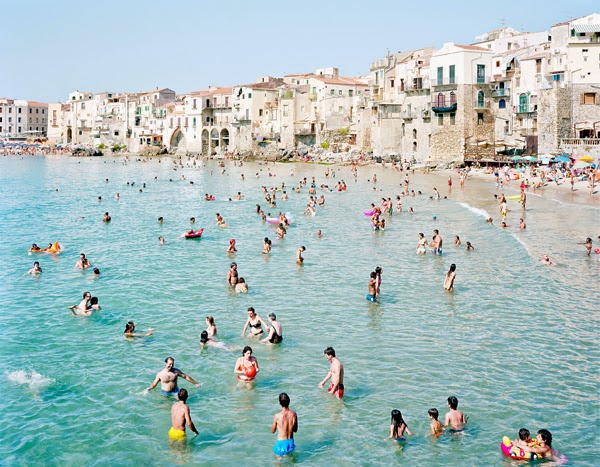
© Massimo Vitali, Cefalu’ Orange Yellow Blue, 2008, courtesy of the artist
AD: What is your attitude to film and digital photography?
MV: Let's say I am lucky to have always used film. Film gives you a base for your color. If I started now it would have been much more difficult. With the digital camera you have no limits, you have to invent your color. What I do involves a very slight change in the colors. I make them a bit lighter, but I do not really change the colors. With this little difference I can have my own palette. For me it would have been much more difficult if I had to invent my colors from scratch. It's really too much for my imagination!
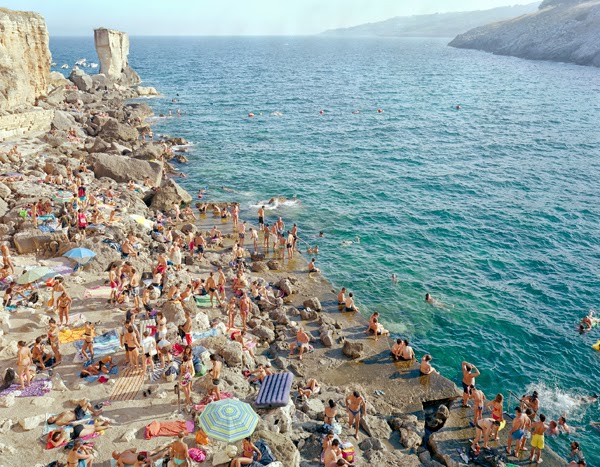
© Massimo Vitali, Porto Miggiano Horizontal, 2011, courtesy of the artist
AD: So, now you work with film and a digital camera?
MV: Yes, I am not a racist, but obviously film is my base and is always in the back of my head.
AD: You like to shoot crowds. What do you find so fascinating about them?
MV: I am interested in people and I am interested in the stories that people have behind them. When you have a certain amount of people you have a large number of stories that you can watch. I was talking about this the other day at a lecture at the Tate in London about landscape photography. Sometimes I take the picture and after I have taken the picture I just stay up there on my scaffolding and keep watching people, just because I like to. It’s very voyeuristic but I am not ashamed of this. I have my fantasies, I invent things.
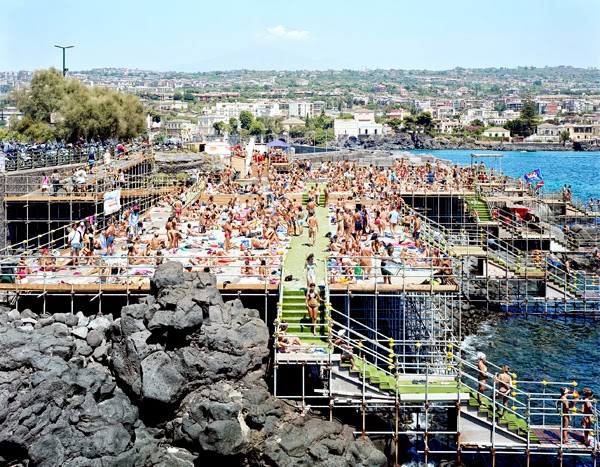
© Massimo Vitali, Catania Under the Volcano, 2007, courtesy of the artist
AD: And how can you define the genre you are working in?
MV: I would call it a sociological anthropological view within a landscape – socio-anthro-landscape. And then sometimes you see things outside of normality, some shocking things, but not very often. I try to keep everything simple so I can pay more attention to what people are actually doing.
AD: You have shows all over the world. How do people react to your work in different countries? In different or similar ways?
MV: I would not say it's a difference between countries. I would say that the different reactions I get show how much people know about the history of photography and the history of art in general. The more people know about the history of photography, the more they understand. My problem is that I have a lot of fans, but some of them only look at nice color, the girls in bikinis, so they only see these superficial things. And for me that's a bit of a problem. My work has many more layers and I hope that they are perceived by the viewer. A pretty beach is the first thing you see, but you have to step back, wait a minute, try to think, let your mind improvise. Once there was a woman who went around saying: “But these pictures are tragic!” Exactly! This is what I want! People try to understand, but very few people do. Somehow there is a hidden tragedy in my work. Apparently, everybody is joyful and happy, but there is a hidden sense of tragedy. That comes from all the problems of our society. I am not taking pictures just to entertain people. I always try to give them something to think about. One has to start thinking that at the same place there are a lot of beautiful things but there are also a lot of problems. I have heard some people saying: your pictures are self-explanatory, you do not need to put any effort into explaining them. No, I have to put that effort in, because sometimes people do not want to see the deeper layers of my work and their significance. I am currently working on a series of pictures on this theme , so let's see, how it turns out.

© Massimo Vitali, Gupiyuri, 2011, courtesy of the artist
AD: You used to work in the cinema. What did you find in photography that you could not find in the cinema?
MV: In photography I have total freedom. I drive to my lab, I think about something, and then I come back and do it. In the cinema you have to have seventy people to work with you, so you have no possibility of really doing your own thing. Of course, it depends at what level you are working, because if you are working at the top level, maybe you can also have ideas, but a director of photography in a movie is not really free in what he does. There is too much involved, too much money at stake to be able to do what you want. All your ideas are conditioned to the amount of money you are allowed to spend. I think that even great directors of photography don't really have the same possibility of inventing things as photographers do. Of course, it is not only the amount of money, it’s the crew costs, actors, producers - you have so many people you have to be in touch with... I just prefer to make my own decisions and maybe once in awhile have a discussion with my friends, but at the end of the day it's me who decides and not some executive in an office somewhere!
AD: Thank you, Massimo! We wish you all the best!
Massimo Vitali's personal site is here.
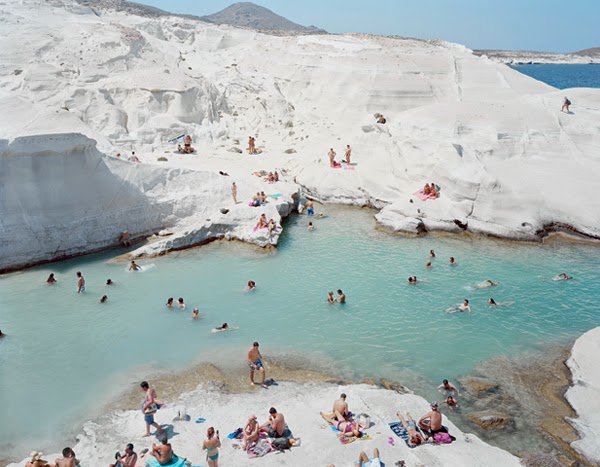

© Massimo Vitali, Lençois Laguna do Peixe, 2012, courtesy of the artist

© Massimo Vitali, Lampedusa New Diptych, 2012, courtesy of the artist
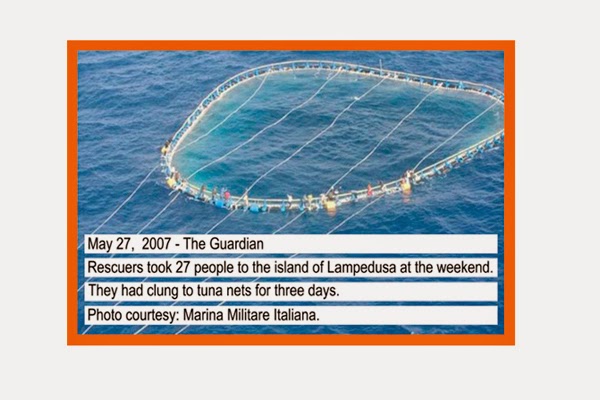
© Massimo Vitali, Lampedusa New Diptych (detail), 2012, courtesy of the artist
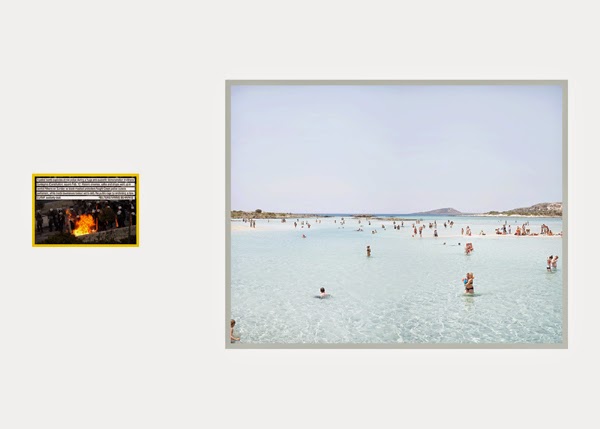
© Massimo Vitali, Greece New Diptych, 2013, courtesy of the artist

© Massimo Vitali, Greece New Diptych (detail), 2013, courtesy of the artist

ArtDependence Magazine is an international magazine covering all spheres of contemporary art, as well as modern and classical art.
ArtDependence features the latest art news, highlighting interviews with today’s most influential artists, galleries, curators, collectors, fair directors and individuals at the axis of the arts.
The magazine also covers series of articles and reviews on critical art events, new publications and other foremost happenings in the art world.
If you would like to submit events or editorial content to ArtDependence Magazine, please feel free to reach the magazine via the contact page.